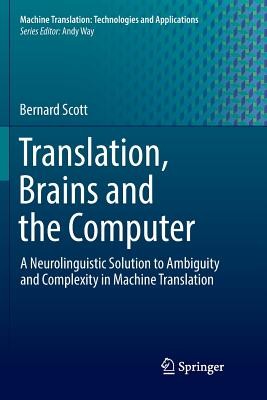
- We will send in 10–14 business days.
- Author: Bernard Scott
- Publisher: Springer
- ISBN-10: 303009538X
- ISBN-13: 9783030095383
- Format: 15.6 x 23.4 x 1.4 cm, minkšti viršeliai
- Language: English
- SAVE -10% with code: EXTRA
Reviews
Description
1 Introduction.- 2 Background.- Logos Model Beginnings.- Advent of Statistical MT.- Overview of Logos Model Translation Process.- Psycholinguistic and Neurolinguistic Assumptions.- On Language and Grammar.- Conclusion.- 3 - Language and Ambiguity: Psycholinguistic Perspectives.- Levels of Ambiguity.- Language Acquisition and Translation.- Psycholinguistic Bases of Language Skills.- Practical Implications for Machine Translation.- Psycholinguistics in a Machine.- Conclusion.- 4- Language and Complexity: Neurolinguistic Perspectives .- Cognitive Complexity.- A Role for Semantic Abstraction.- Connectionism and Brain Simulation.- Logos Model as a Neural Network.- Language Processing in the Brain.- MT Performance and Underlying Competence.- Conclusion.- 5 - Syntax and Semantics: Dichotomy or Integration? .- Syntax versus Semantics: Is There a Third, Semantico- Syntactic Perspective?.- Recent Views of the Cerebral Process.- Syntax and Semantics: How Do They Relate?.- Conclusion.- 6 -Logos Model: Design and Performance.- The Translation Problem.- How Do You Represent Natural Language?.- How Do You Store Linguistic Knowledge?.- How Do You Apply Stored Knowledge To The Input Stream?.- How do you Effect Target Transfer and Generation?.- How Do You Deal with Complexity Issues?.- Conclusion.- 7 - Some limits on Translation Quality.- First Example.- Second Example.- Other Translation Examples.- Balancing the Picture.- Conclusion.- 8 - Deep Learning MT and Logos Model.- Points of Similarity and Differences.- Deep Learning, Logos Model and the Brain.- On Learning.- The Hippocampus Again.- Conclusion.- Part II.- The SAL Representation Language.- SAL Nouns.- SAL Verbs.- SAL Adjectives.- SAL Adverbs.
EXTRA 10 % discount with code: EXTRA
The promotion ends in 22d.05:44:19
The discount code is valid when purchasing from 10 €. Discounts do not stack.
- Author: Bernard Scott
- Publisher: Springer
- ISBN-10: 303009538X
- ISBN-13: 9783030095383
- Format: 15.6 x 23.4 x 1.4 cm, minkšti viršeliai
- Language: English English
1 Introduction.- 2 Background.- Logos Model Beginnings.- Advent of Statistical MT.- Overview of Logos Model Translation Process.- Psycholinguistic and Neurolinguistic Assumptions.- On Language and Grammar.- Conclusion.- 3 - Language and Ambiguity: Psycholinguistic Perspectives.- Levels of Ambiguity.- Language Acquisition and Translation.- Psycholinguistic Bases of Language Skills.- Practical Implications for Machine Translation.- Psycholinguistics in a Machine.- Conclusion.- 4- Language and Complexity: Neurolinguistic Perspectives .- Cognitive Complexity.- A Role for Semantic Abstraction.- Connectionism and Brain Simulation.- Logos Model as a Neural Network.- Language Processing in the Brain.- MT Performance and Underlying Competence.- Conclusion.- 5 - Syntax and Semantics: Dichotomy or Integration? .- Syntax versus Semantics: Is There a Third, Semantico- Syntactic Perspective?.- Recent Views of the Cerebral Process.- Syntax and Semantics: How Do They Relate?.- Conclusion.- 6 -Logos Model: Design and Performance.- The Translation Problem.- How Do You Represent Natural Language?.- How Do You Store Linguistic Knowledge?.- How Do You Apply Stored Knowledge To The Input Stream?.- How do you Effect Target Transfer and Generation?.- How Do You Deal with Complexity Issues?.- Conclusion.- 7 - Some limits on Translation Quality.- First Example.- Second Example.- Other Translation Examples.- Balancing the Picture.- Conclusion.- 8 - Deep Learning MT and Logos Model.- Points of Similarity and Differences.- Deep Learning, Logos Model and the Brain.- On Learning.- The Hippocampus Again.- Conclusion.- Part II.- The SAL Representation Language.- SAL Nouns.- SAL Verbs.- SAL Adjectives.- SAL Adverbs.


Reviews